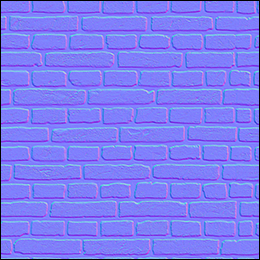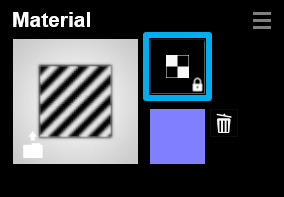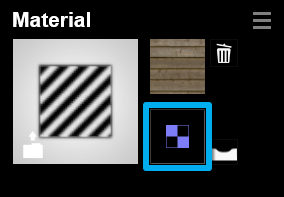1. Background
A material without a Normal Map will often look flat and lifeless:

Adding a Normal Map to the material will make it appear more three-dimensional when it is lit up by the sun or by artificial light sources:

There are two ways to add a Normal Map to a material:
- Use the Normal Map generator in Lumion to create a Normal Map for your material.
- Use a Normal Map from a 3rd party application and assign it to your material.
2. Using the Normal Map generator
2.1: If you have imported a textured model in Lumion and assigned a Standard Material to it, you can improve the depth details from the texture by clicking on the Create Normal Map button. In addition to the Normal Map, it also generates a Gloss mask in the alpha channel of the Normal Map which will improve the way the material reflects its surroundings:

2.2: If you click on the Color Map to load a new Color Map texture, the Normal Map generator will automatically generate a new Normal Map and Gloss mask for you, so that you don't need to click on the Create Normal Map button:

2.3: Make sure that the sun or a Spotlight is lighting up the surface when evaluating the result. If the depth details of the material appear to be wrong, simply click on the Flip Normal Map direction button to reverse the direction:

Before clicking on the Flip Normal Map direction button:

After clicking on the Flip Normal Map direction button:

2.4: Adjust the Relief slider to your liking. A high Relief slider value will enhance the depth details:

3. Using Normal Maps from 3rd party applications
Normal Maps can be created in many different applications. Here are some examples:
Example of a Normal Map for brick texture:

3.1: To get the best possible result, you should also create a Gloss mask if possible. Some of the applications above can create a Gloss mask for you. The Gloss mask should be added to the Alpha Channel of the Normal Map in Adobe Photoshop or a similar image editor:
Example of a Gloss mask for a brick texture:

3.2: If you are using Adobe Photoshop, please click on the link below to see how to add an Alpha Channel to an image:
- External Link: Adobe Photoshop Help: Create and edit alpha channel masks
3.3: Then paint the Alpha Channel with grayscale tones. A pure black color will result in very blurry reflections in Lumion and a pure white color will result in sharp, mirror-like reflections. Grayscale tones will result in more or less sharp reflections depending on how close they are to pure black and pure white.
3.4: Once you've added the Gloss mask to the Alpha Channel of the texture, please click on the link below to see how to save it to a 32-bit Color Map (Diffuse) texture in TGA, BMP or TIFF format.
- External Link: Adobe Photoshop Help: Save files in graphics formats
3.5: Then open Lumion and add a Standard Material to the surface:

3.6: If your material does not have a Color Map texture, then click on the Color Map slot to load the texture:

3.7: Then click on the Normal Map slot to load the Normal Map texture you created earlier:

3.8: Adjust the Relief slider to your liking. A high Relief slider value will enhance the depth details:
